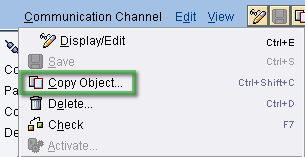USE:
In order to To test synchronous interfaces with int4 Int4 IFTT, a new receiver Communication Channel should be created on the PI. This channel should be a copy
copy of the sender communication channel used by the tested interface. The Target URL of the newly created receiver communication channel should be the sender channel endpoint.
PROCEDURE:
- On PI, find the Integrated Configuration (ICO) that is used in the tested scenario.
- Locate the sender Communication Channel in ICO → Inbound Processing and enter its configuration
- Copy the entire object
- Change its name to 'receiver' and add a suffix to distinguish it from other communication channels used in the scenario.
- Below you will find a sample receiver Communication Channel configuration for HTTP and SOAP adapter:
A) HTTP:
a) Enter sender channel endpoint as the Target URL of the newly created receiver channel:
[PI url]:port/HttpAdapter/HttpMessageServlet?interfaceNamespace=[interface namespace]&interface=[interface name]&senderService=[channel communication component]&qos=BE
Please take notice that for HTTP, you should use a SOAP adapter, but with the "Do not use SOAP envelope" conversion parameter ON. .
b) In the module tab, add the XISOAPAdapterBean module.
B) SOAP:
a) Enter sender channel endpoint as the Target URL of the newly created receiver channel:
[PI url]:port/XISOAPAdapter/MessageServlet?senderParty=&senderService=[channel communication component]&receiverParty=&receiverService=&interface=[interface name]&interfaceNamespace=[interface namespace]
b) In the module tab, add the XISOAPAdapterBean module.
To complete the synchronous interface configuration in Int4 IFTT, add the following data as additional parameters in the Object Definition of your synchronous scenario:
- the business component of a receiver channel for the sender
- receiver communication channel for the sender
- party of a receiver channel for sender (if blank in the ICO on PI, leave it empty in Int4 IFTT configuration)







